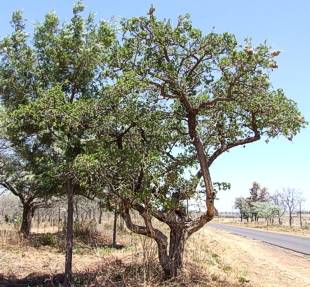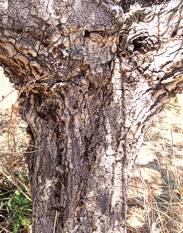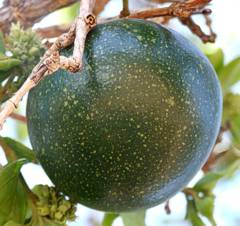Strychnos cocculoides
Strychnos cocculoides Baker
Family: Loganiaceae
Common names: corky-bark monkey-orange (Eng.); kurkbasklapper (Afr.); morapa (North Sotho); omusu (otjiHerero); liguni, maguni (Ovambo) Tree No: Zimbabwe 881
SA Tree No: 623
Introduction
Strychnos cocculoides is a monkey-orange with distinctive corky bark, leaves without sharp tips and large, green, cannonball-like fruits, and is found in the drier parts of tropical and southern Africa.

Description
Description
Strychnos cocculoides is an evergreen tree up to about 8 m tall; crown spreading in isolated trees but narrow in clumps; bark characteristically pale grey, corky and deeply fissured more or less along the trunk axis. Very young twigs hairy, yellowish green, soon becoming grey or brown, quite stout, corky, tips sometimes hardening into thorns. Leaves opposite, each pair at right angles to those immediately above and below it, 18-80 x 15-60 mm, oblong to egg-shaped, rounded at both ends, surface softly hairy, losing the hairs on top with age; margin not toothed, stalk 2-8 mm long, hairy.

Flowers in clusters, 25-40 mm long, on stalks 5-15 mm long at the ends of branches. Individual flowers small, green, with parts in fives; ovary with 2 chambers. Fruit a woody-shelled, green berry 16-70 mm in diameter, eventually turning orange when (over-)ripe, pulp whitish, seeds several, 12-20 x 8-15 x 2.5-4.0 mm. Flowering season is said to be September to November, with fruit ripening a few months later, but both flower and fruit pictures illustrating this article were taken on the same day in July, and show the same tree.

Conservation Status
Status
Strychnos cocculoides, a common and widespread tree is not listed as being threatened or specially conserved.
Distribution and habitat
Distribution description
The corky-bark monkey-orange is widespread in Limpopo, Mpumalanga and North-West Provinces, South Africa; Botswana, Zimbabwe, Zambia, northern Namibia, Angola and eastwards to Tanzania, Mozambique and southernmost Kenya (Bruce & Lewis 1960; Von Breitenbach 1965; Beentje 1994). Among the easiest places for residents of the major population centres of South Africa to see trees of this species are the roadsides of a network of minor roads in the triangle bounded by Bela Bela, Modimolle and Vaalwater. The tree is usually found in open woodland on flat, sandy soil or rocky slopes; the area specifically mentioned is on the sandy western fringe of the Springbok Flats.

Derivation of name and historical aspects
History
The Greek word strychnos was used in Classical times to indicate several plants, whose common character was that they are all poisonous. The Latin word cocculoides means resembling a small berry. The fruits of this tree are indeed round and fall within the botanical definition of a berry, but they are large compared to most fruits that are commonly called berries.
The genus Strychnos is pantropical, and includes some 170 species, of which about a dozen are southern African and twice as many occur in south tropical Africa. In our region they are usually trees, but in West Africa many species are lianes. The genus is the sole member of the family Strychnaceae, but is included in Loganiaceae in earlier works. One economically significant species is the Indian S. nux-vomica, the commercial source of the poison strychnine.

Ecology
Ecology
This tree grows in woodlands that are burnt essentially annually, and so the most obvious ecological adaptation concerns a strategy for surviving fire. Woody plants growing in these conditions have developed two main strategies for survival: they either keep reserves safely underground and sprout new aerial growth after every fire, or protect the main trunk and as many branches as possible from the heat as the fire passes through. The common name tells us how this tree achieves the second strategy: it is the corky-barked monkey-orange. This bark is by its nature insulating (think of cork tiles etc.) and does not burn readily, and so after a fire, trees with bark like this can rapidly exploit the new source of fertilizer, if only because their leaves stand above those of plants still pushing new growth out of the ground.
The inconspicuous green flowers suggest that the pollinator (none has been recorded for this tree) detects the presence of pollen and nectar by some means other than sight. What that means is, remains a subject for future investigation. The fruits suggest that the dispersal mechanism of the seeds involves a herbivorous mammal. The woody shell of the fruit makes one think of something with either large, strong jaws (like a rhino) or good teeth and a great deal of patience (like a rodent). The latter would be better placed to exploit the flesh in the fruit and leave the seeds alone, but the former may be more use to the tree, as it would be capable of eating and digesting the fruit without damaging the seeds. There are no published studies of the dispersal of this tree, and so which of these possibilities is nearer to being correct remains to be seen.
Uses
Use
For many years from about 1958, the reverse of the (colonial) Angolan 20$00 note featured a scene of antelope in grassland, shaded by a tree with conspicuous large fruits. I am reliably informed that the only tree with such large, round fruits indigenous to Angola is Strychnos cocculoides, which would make the subject of this article one of the few indigenous African plants to be recognizably illustrated on any form of currency. Because of the stringent laws most countries have about illustrating currency, no image is presented here, but there is one in Pick (1984).
The fruits are eaten fresh in the area where this tree grows naturally. Note that in many species of Strychnos the seeds are poisonous, and so SANBI advises caution (or better, abstinence) in experimenting with this. Remember that a related tree, S. nux-vomica is the commercial source of strychnine. This used to be used medicinally on humans, but has been superseded by safer drugs, but Burkill (1995) reminds us that this alkaloid is still an important ingredient in rat poison.
Schmidt et al. (2002) record that the wood is white and pliable, and has been used to make tool handles. They also state that the fruit is reputedly among the more tasty in the genus.
Growing Strychnos cocculoides
Grow
The almost complete absence of any published accounts of the cultivation of this tree suggests that nobody has ever tried it with any success. In the only mention of the species I have found in the context of cultivation, Carr (1994) reports that he was unable to obtain seed on which to experiment.
Watt & Breyer-Brandwijk (1963) note reports that both seeds and bark of this tree are poisonous; it would therefore be a potential disaster in a garden that also houses small children. However some mature trees do have a characteristic Pierneef-Bushveld shape which may make them attractive to collectors or bonsai fanciers.
In the absence of any firm evidence, one imagines that seed would germinate slowly if sown in a moderately sandy soil (based on Carr's reported experience with the closely related Strychnos spinosa). One may expect corky-bark monkey-orange to require a frost-free environment, but to be fairly resistant to drought. Nothing is known about its susceptibility or otherwise to garden pests and diseases.
References
- Balkwill, K., Boon, R., Coates Palgrave, M., Glen, H.F., Jordaan, M., Lötter, M., Schmidt, E. & Thomas, V. 2004. SAPPI Tree spotting: lifer list. Jacana, Johannesburg.
- Beentje, H. 1994. Kenya trees, shrubs and lianes. National Museums of Kenya, Nairobi.
- Bruce, E.A. & Lewis, J. 1960. Loganiaceae. Flora of tropical East Africa. Crown Agents, London.
- Burkill, H.M. 1995. The useful plants of West tropical Africa. Royal Botanic Gardens, Kew.
- Carr, J.D. 1994. The propagation and cultivation of indigenous trees and shrubs on the highveld. Sandton Nature Conservation Society and the Tree Society of South Africa, Johannesburg.
- Glen, H.F. 2004. SAPPI What's in a Name? Jacana, Johannesburg.
- Pick, A. 1984. Standard catalog of world paper money, edn 4. Krause Publications, Iola WI, USA.
- Schmidt, E., Lötter, M. & McCleland, W. 2002. Trees and shrubs of Mpumalanga and the Kruger National Park. Jacana, Johannesburg.
- Von Breitenbach, F. 1965. The indigenous trees of southern Africa. Government Printer, Pretoria.
- Watt, J.M. & Breyer-Brandwijk, M.G. 1963. The medicinal and poisonous plants of southern and eastern Africa, edn 2. Oliver & Boyd, Edinburgh.
Credits
Hugh Glen
KwaZulu-Natal Herbarium
August 2009
Acknowledgements: The author thanks Aurelio Balsinhas, late of the National Herbarium, Pretoria, for his identification of the tree on the Angolan banknotes. Without the help of Walter and Jill Barker of the Tree Society of South Africa I would not have been able to obtain the pictures accompanying this article. Adekunle Adebowale (Ph.D. student at University of Kwazulu-Natal ) provided me with the information on the habit of West African Strychnos.
Plant Attributes:
Plant Type: Tree
SA Distribution: Limpopo, Mpumalanga
Soil type: Sandy, Loam
Flowering season: Spring, Early Summer
PH: Neutral
Flower colour: Green, White
Aspect: Full Sun
Gardening skill: Average
Special Features:
Horticultural zones








Rate this article
Article well written and informative
Rate this plant
Is this an interesting plant?
Login to add your Comment
Back to topNot registered yet? Click here to register.